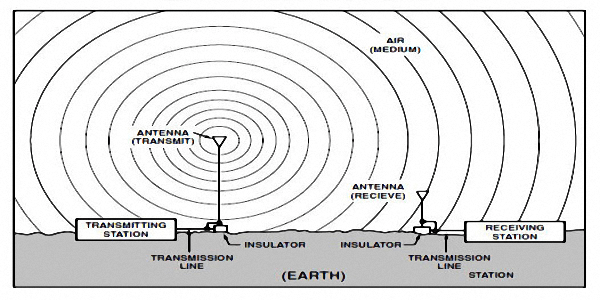Ham Radio Propagation Conditions
by siteadmin

In addition to solar flares, there are other factors that can affect ham radio communications. This article discusses some of those things that you may need to consider when making a ham radio contact in reference to amateur radio band conditions.
The HF portion of the radio spectrum uses the ionosphere to bounce electromagnetic waves off of charged particles in the atmosphere, allowing signals to travel across vast distances. The ionosphere is in the upper reaches of the atmosphere, ranging from 400 km to over a million km above Earth's surface.
Solar Cycle
Every 11 years or so, the sun's magnetic field flips, affecting the amount of activity on the solar surface. During this period, the sun's activity goes from low to high and back down again. This is called the solar cycle.
During this time, the number of sunspots on the sun's surface increases and giant eruptions occur, like solar flares. These eruptions can cause lights in the sky or even affect Earth's electricity grid.
The solar cycle can also cause large geomagnetic storms on Earth, which can affect communications and GPS satellites. These space weather events can also pose a risk to astronauts on the International Space Station.
This is because the ionization level of the F and E layers in the atmosphere is increased during the active phase of the solar cycle. This can make it difficult for ham radio operators to receive signals from stations located far away.
However, there are a few things that ham radio operators can do to help minimize the impact of the solar cycle on their operation. One way is to use a propagation prediction programme.
Another way is to keep an eye on the solar cycle and take note of the effects it has on different ham radio bands. This information will be helpful for predicting how your signals will propagate in the future.
In the upper HF bands, ham radio operators can use a propagation prediction program to predict how their signal will be received by other stations. This helps them prepare before they activate their antennas and turn on the radio.
These programs can also give a forecast of when the solar cycle will peak, which is important because it helps ham radio operators prepare for the maximum of solar activity so they can avoid being caught off guard.
The Sun's magnetic field can also affect radio propagation in the ionosphere. This is a major factor for determining the quality of ham radio communication on the HF bands.
Solar Weather
Whether you're an amateur radio operator or just curious, you may be surprised to learn that the weather on Earth isn't always what we would call "normal." Space weather can disrupt all sorts of things from satellite communications to electrical power.
Solar activity is a big part of space weather, and it affects ham radio communications as well. It can cause interference with HF and VHF radio signals.
When a solar flare occurs, charged particles in the sun's atmosphere can interrupt radio waves on Earth, either by degrading them or completely absorbing them. These disturbances can last for hours or even days.
Another type of space weather, a radiation storm, can also have an impact on HF radio communications. These storms are caused by energetic solar protons that collide with Earth's upper atmosphere. The resulting electrons enhance the D-Layer of the ionosphere and can interfere with HF radio transmissions in high latitudes.
This type of space weather can be more severe than X-rays and can be especially noticeable in the polar regions where the auroral display occurs most often. It can cause radio blackouts and can be accompanied by a sudden rise of ionization in the D and F layers of the ionosphere, which can interfere with HF radio communication.
Other solar weather phenomena include 'coronal mass ejections' (CMEs) and Sudden Ionospheric Disturbances' (SIDs). SIDs can cause radio blackouts, which can be brief but can be very disruptive to communication.
SIDs are triggered by large bursts of solar ionizing radiation, such as an X-class solar flare or a CME, which can be a result of a coronal hole. The ionizing radiation energizes the charged particles in the solar atmosphere, which are then ejected from the Sun over a period of time.
It's important to understand that the ionosphere is a complex system that responds to variations in space weather and solar activity. For a ham radio communicator, it's critical to understand how to best manage the effects of space weather so that you can continue to make good contacts 24 hours a day.
Ionosphere
The ionosphere is an electrically active layer of gas molecules and atoms that surrounds Earth. These are negatively charged (called free electrons) and positively charged (called ions). This combination creates an environment that can reflect or refract radio waves, which is why it is important for ham radio communications.
As a result of solar activity and other effects from space, such as hurricanes or thunderstorms, the ionosphere can change. Its response to these changes is known as space weather.
This effect can also be caused by turbulence in the ionosphere and by plasma instabilities. This causes rapid fluctuations in the ionosphere's refraction index, which can affect radio signals.
When these irregularities occur, the amplitude and phase of the radio wave changes rapidly. This type of rapid fluctuation is called ionospheric radio scintillation.
The most important factor affecting the ionospheric environment is its charge density. This is determined by how much of the sun's energy penetrates the atmosphere. It varies with the seasons and with geographical location (polar, auroral zones, mid-latitudes, and equatorial regions).
Ionization of the F layer is highest around 1 hour after the sunrise, but is relatively low until sunset. The D and E layers are very weakly ionized, while the F2 layer is the most heavily ionized during the daytime.
In addition to ionization, the ionosphere's charge density also contributes to the refraction and reflection of HF radiation. This can extend the radio transmission range by bouncing a radio wave off of the ionized air.
Because of this refraction, ham radio operators can transmit at a lower frequency than would otherwise be possible. This can be especially useful for short distances, as the curvature of the Earth limits the signal's ability to travel long distances.
However, hams should be aware that there is another ionospheric layer that can also affect HF communication: the skip zone. The skip zone is a circular area where the ionospheric reflection/refraction of a radio wave bounces back up toward the receiver. It can reach a significant distance, but the loss of the signal is greater with each bounce.
Tropospheric Ducting
Tropospheric ducting is an atmospheric phenomenon that can affect the propagation of ham radio signals. It occurs when a mass of air is heated to much greater than its surrounding air and forms a thermal inversion. This temperature inversion causes the air below it to be warmer than the air above it and to have a significantly higher refractive index. The air below the inversion boundary can act as a "waveguide" or tropospheric duct that allows signals to travel long distances.
The condition of the ducting can vary depending on the temperature and humidity levels in the air. Strong temperature inversions occur during weather conditions that have a large difference between the air above and below it, such as the tropics or over large bodies of water. Often, the ducting can extend for hundreds or even thousands of kilometers, and is a serious concern for ham radio operators who want to communicate across great distances.
In addition to the ducting, there are also other factors that may affect ham radio communication. For example, if the ducting is accompanied by high winds or windless conditions, it can degrade the signal quality. This can be a problem for operators who are trying to work remote stations and is particularly true for those operating in remote areas, such as in the tropics.
Another type of ham radio interference is known as tropo-scatter, which can be received at very long distances. This is a phenomenon that occurs when the air above and below a receiver is separated by a low refraction distance, usually about 10 km.
When a receiver is near the edge of this scattering region, a weak signal will be reflected off the bottom of the refraction zone and subsequently re-entered into the atmosphere where it will again be refracted away from the transmitting station and re-received to Earth. This type of propagation is common at very low frequencies, such as on 40 MHz.
At S706, geographic characteristics of received interference may be analyzed to identify instances where the same interference event is experienced by multiple receivers in a relatively broad geographic area, such as over a hundred square miles. This type of geographic characteristic, which is generally used to identify multi-site interference events, is also useful for identifying local sources of interference that do not relate to tropospheric ducting.
In addition to solar flares, there are other factors that can affect ham radio communications. This article discusses some of those things that you may need to consider when making a ham radio contact in reference to amateur radio band conditions. The HF portion of the radio spectrum uses the ionosphere to bounce electromagnetic waves…
Recent Posts
- Lawn Care Spring Branch Advocates for Property Care: Combatting Weed Growth and Preserving Curb Appeal
- Signs It’s Time to Hire a Roofer in Lexington, KY
- Maximizing Space: Small Bathroom Remodeling Tips for Lexington Residents
- Addressing Common Plumbing Issues in Strongsville Homes
- Safe Havens: Ensuring the Well-being of Homeless Youth in Lexington, KY
